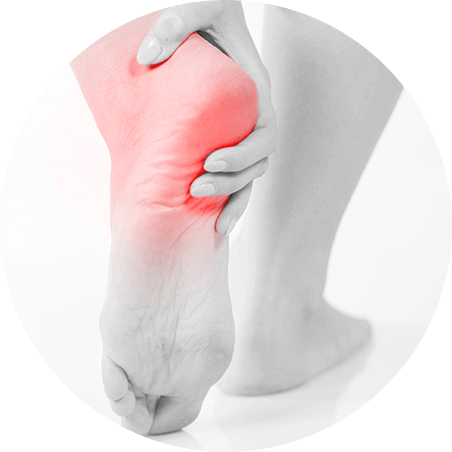
"Don't ignore your heel pain."
Plantar Fascitis
Plantar fasciitis is a common foot condition that involves inflammation of the plantar fascia, a thick band of tissue that runs along the bottom of the foot, connecting the heel bone to the toes. The plantar fascia acts as a shock absorber and supports the arch of the foot during walking and running.
Symptoms:
The primary symptom of plantar fasciitis is heel pain, which is usually most pronounced in the morning when you take your first steps out of bed or after prolonged periods of rest. The pain may also be triggered or aggravated by activities that put stress on the foot, such as standing, walking, running, or climbing stairs. The pain is often described as a sharp, stabbing sensation or a dull ache.
Causes:
1.Plantar fasciitis typically occurs due to repetitive strain and stress on the plantar fascia, leading to microtears in the tissue and subsequent inflammation. Several factors can contribute to its development, including:
2.Overuse or excessive physical activity: Engaging in activities that involve repetitive impact on the feet, such as running, dancing, or high-impact sports, can strain the plantar fascia.
3.Foot structure: Flat feet, high arches, or abnormal walking patterns can put extra stress on the plantar fascia.
4.Improper footwear: Wearing shoes with inadequate arch support, cushioning, or poor shock absorption can increase the risk of plantar fasciitis.
5.Age: Plantar fasciitis is more common in people between the ages of 40 and 60.
6.Obesity: Being overweight can increase the load on the feet and aggravate the condition.
Treatment:
The majority of plantar fasciitis cases can be treated non-surgically. Some common treatment options include:
1.Rest: Reducing or avoiding activities that worsen the pain can give the plantar fascia time to heal.
2.Ice: Applying ice to the affected area can help reduce inflammation and alleviate pain.
3.Stretching exercises: Specific stretching exercises for the calf muscles and plantar fascia can improve flexibility and reduce tension.
4.Supportive footwear: Wearing shoes with good arch support and cushioning can help relieve pressure on the plantar fascia.
5.Orthotic devices: Custom or over-the-counter shoe inserts can provide additional support and reduce strain on the fascia.
6.Physical therapy: A physical therapist can provide targeted exercises and techniques to promote healing and prevent recurrence.
7.Nonsteroidal anti-inflammatory drugs (NSAIDs): Over-the-counter pain relievers like ibuprofen or naproxen may help reduce pain and inflammation.
If conservative treatments do not provide relief, more invasive options like corticosteroid injections or shockwave therapy may be considered. Surgery is typically a last resort and is only considered if all other treatments have failed to improve the condition.
